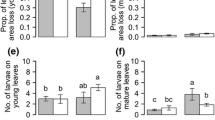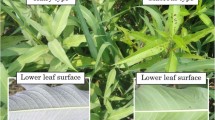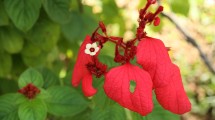Abstract
Frequency-dependent prey choice by natural enemies may influence the coexistence of multiple prey types, but little is known about whether frequency-dependent foraging choice occurs in herbivory on plants showing resistance polymorphism within a single population. Here we examined frequency-dependent foraging by a crucifer-feeding leaf beetle, Phaedon brassicae, on trichome-producing (hairy) and trichomeless (glabrous) plants coexisting within a natural population of the perennial herb Arabidopsis halleri subsp. gemmifera. Larvae of P. brassicae fed on hairy leaves showed slower growth than those fed on glabrous leaves. Although adult beetles consumed similar amounts of leaves when they were fed either hairy or glabrous leaves in no-choice conditions, our choice experiment showed that adult beetles fed at less than the proportionally expected level on hairy leaves compared to glabrous leaves when the hairy leaves were less or equally abundant. Both types of leaves were consumed at the proportionally expected levels when the hairy leaves were more abundant than the glabrous leaves. In a natural population, the leaf damage on the hairy plants was negatively correlated with the local proportion of the glabrous plants in a 1-m diameter patch across 2 years, while correlations between the leaf damage on the glabrous plants and their proportion differed between the 2 years. Additionally, we found five glucosinolates in leaves of A. halleri, but their accumulation did not differ between hairy and glabrous plants. Our experimental results indicate that hairy plants incur less herbivory by P. brassicae when glabrous plants are abundant. The field pattern provides evidence suggestive of frequency-dependent herbivory acting on hairy plants. The present study highlights one of the putative mechanisms of maintaining plant resistance polymorphism.




Similar content being viewed by others
References
Abramoff MD, Magalhaes PJ, Ram SJ (2004) Image processing with image. J Biophotonics Int 11:36–42
Behmer ST, Raubenheimer D, Simpson SJ (2001) Frequency-dependent food selection in locusts: a geometric analysis of the role of nutrient balancing. Anim Behav 61:995–1005
Bergvall UA, Leimar O (2005) Plant secondary compounds and the frequency of food types affect food choice by mammalian herbivores. Ecology 86:2450–2460
Bolker BM, Brooks ME, Clark CJ, Geange SW, Poulsen JR, Stevens MHH, White JSS (2009) Generalized linear mixed models: a practical guide for ecology and evolution. Trends Ecol Evol 24:127–135
Burgess RSL, Ennos RA (1987) Selective grazing of acyanogenic white clover: variation in behaviour among populations of the slug Deroceras reticulatum. Oecologia 73:432–435
Chandra S, Williams G (1983) Frequency-dependent selection in the grazing behaviour of the desert locust Schistocerca Gregaria. Ecol Entomol 8:13–21
Chesson J (1978) Measuring preference in selective predation. Ecology 59:211–215
Clauss MJ, Dietel S, Schubert G, Mitchell-Olds T (2006) Glucosinolate and trichome defenses in a natural Arabidopsis lyrata population. J Chem Ecol 32:2351–2373
Cottam DA (1985) Frequency-dependent grazing by slugs and grasshoppers. J Ecol 73:925–933
Elle E, van Dam NM, Hare JD (1999) Cost of glandular trichomes, a “resistance” character in Datura wrightii Regel (Solanaceae). Evolution 53:22–35
Endler JA (1991) Interactions between predators and prey. In: Krebs JR, Davis NB (eds) Behavioral ecology: an evolutionary approach. Blackwell, London, pp 169–196
Greenwood JJD (1984) The functional basis of frequency-dependent food selection. Biol J Linn Soc 23:177–199
Hoffmann MH (2005) Evolution of the realized climatic niche in the genus: Arabidopsis (Brassicaceae). Evolution 59:1425–1436
Hughes MA (1991) The cyanogenic polymorphism in Trifolium repens L. (white clover). Heredity 66:105–115
Janz N, Bergström A, Johansson J (2005) Frequency dependence of host plant choice within and between patches: a large cage experiment. Evol Ecol 19:289–302
Kawagoe T, Kudoh H (2010) Escape from floral herbivory by early flowering in Arabidopsis halleri subsp. gemmifera. Oecologia 164:713–720
Kawagoe T, Shimizu KK, Kakutani T, Kudoh H (2011) Coexistence of trichome variation in a natural plant population: a combined study using ecological and candidate gene approaches. PLoS ONE 6:e22184
Kivimäki M, Kärkkäinen K, Gaudeul M, Løe G, Ågren J (2007) Gene, phenotype and function: GLABROUS1 and resistance to herbivory in natural populations of Arabidopsis lyrata. Mol Ecol 16:453–462
Kliebenstein DJ, Kroymann J, Brown P, Figuth A, Pedersen D, Gershenzon J, Mitchell-Olds T (2001) Genetic control of natural variation in Arabidopsis glucosinolate accumulation. Plant Physiol 126:811–825
Kubota H, Takenaka C (2003) Arabis gemmifera is a Hyperaccumulator of Cd and Zn. Int J Phytoremediation 5:197–201
Ôtake A, Funaki S (1958) The distribution of Phaedon brassicae Baly, with special reference to influences of the dispersal of the adults upon the distribution of their next generation. Bull Shimane Agric Univ 6:107–116 (in Japanese with English summary)
Pacala SW, Crawley MJ (1992) Herbivores and plant diversity. Am Nat 140:243–260
R Development Core Team (2012) R: a language and environment for statistical computing. R Foundation for Statistical Computing, Vienna
Raffa K, Havill N, Nordheim E (2002) How many choices can your test animal compare effectively? Evaluating a critical assumption of behavioral preference tests. Oecologia 133:422–429
Sawada Y, Akiyama K, Sakata A, Kuwahara A, Otsuki H, Sakurai T, Saito K, Hirai MY (2009a) Widely targeted metabolomics based on large-scale MS/MS data for elucidating metabolite accumulation patterns in plants. Plant Cell Physiol 50:37–47
Sawada Y, Toyooka K, Kuwahara A, Sakata A, Nagano M, Saito K, Hirai MY (2009b) Arabidopsis bile acid: sodium symporter family protein 5 is involved in methionine-derived glucosinolate biosynthesis. Plant Cell Physiol 50:1579–1586
Sawada Y, Nakabayashi R, Yamada Y, Suzuki M, Sato M, Sakata A, Akiyama K, Sakurai T, Matsuda F, Aoki T, Hirai MY, Saito K (2012) RIKEN tandem mass spectral database (ReSpect) for phytochemicals: a plant-specific MS/MS-based data resource and database. Phytochemistry 82:38–45
Sherratt TN, Harvey IF (1993) Frequency-dependent food selection by arthropods: a review. Biol J Linn Soc 48:167–186
Sletvold N, Ågren J (2012) Variation in tolerance to drought among Scandinavian populations of Arabidopsis lyrata. Evol Ecol 26:559–577
Sletvold N, Huttunen P, Handley R, Kärkkäinen K, Ågren J (2010) Cost of trichome production and resistance to a specialist insect herbivore in Arabidopsis lyrata. Evol Ecol 24:1307–1319
Steets JA, Takebayashi N, Byrnes JM, Wolf DE (2010) Heterogeneous selection on trichome production in Alaskan Arabidopsis kamchatica (Brassicaceae). Am J Bot 97:1098–1108
Wagner GJ, Wang E, Shepherd RW (2004) New approaches for studying and exploiting an old protuberance, the plant trichome. Ann Bot 93:3–11
Wang XP, Zhou XM, Wang YY, Lei CL (2007a) Internal reproductive system and diapausing morphology of the Brassica leaf beetle Phaedon brassicae Baly (Coleoptera: Chrysomelidae: Chrysomelinae). The Coleopterists Bulletin 61:457–462
Wang XP, Zhou XM, Wang YY, Lei CL (2007b) Development, survival and reproduction of the Brassica leaf beetle, Phaedon brassicae Baly (Coleoptera: Chrysomelidae) under different thermal conditions. Pan-Pacific Entomol 83:143–151
Wise MJ, Yi CG, Abrahamson WG (2009) Associational resistance, gall-fly preferences, and a stem dimorphism in Solidago altissima. Acta Oecologica 35:471–476
Yoshida Y, Sano R, Wada T, Takabayashi J, Okada K (2009) Jasmonic acid control of GLABRA3 links inducible defense and trichome patterning in Arabidopsis. Development 136:1039–1048
Zhao FJ, Lombi E, Breedon T, McGrath SP (2000) Zinc hyperaccumulation and cellular distribution in Arabidopsis halleri. Plant Cell Environ 23:507–514
Acknowledgments
We thank Drs. A. Yamawo, A. J. Nagano and K. H. Ito for valuable comments during the study, and T. F. Haraguchi and M. Sato for technical support of glucosinolate analysis. Thanks are also given to Dr. A. Biere and an anonymous reviewer for helpful comments on the manuscript. This study was funded by the NEXT Program (GS013) to H. Kudoh. The glucosinolate analysis was supported by Japan Advanced Plant Science Network. Y. Sato was supported by a research assistant fellowship provided by the Center for Ecological Research and by the Grants for Excellent Graduate Schools Program, Kyoto University (Ministry of Education, Culture, Sports, Science and Technology, Japan). The authors declare that there is no conflict of interest regarding this work.
Author information
Authors and Affiliations
Corresponding author
Electronic supplementary material
Below is the link to the electronic supplementary material.
Rights and permissions
About this article
Cite this article
Sato, Y., Kawagoe, T., Sawada, Y. et al. Frequency-dependent herbivory by a leaf beetle, Phaedon brassicae, on hairy and glabrous plants of Arabidopsis halleri subsp. gemmifera . Evol Ecol 28, 545–559 (2014). https://doi.org/10.1007/s10682-013-9686-3
Received:
Accepted:
Published:
Issue Date:
DOI: https://doi.org/10.1007/s10682-013-9686-3




